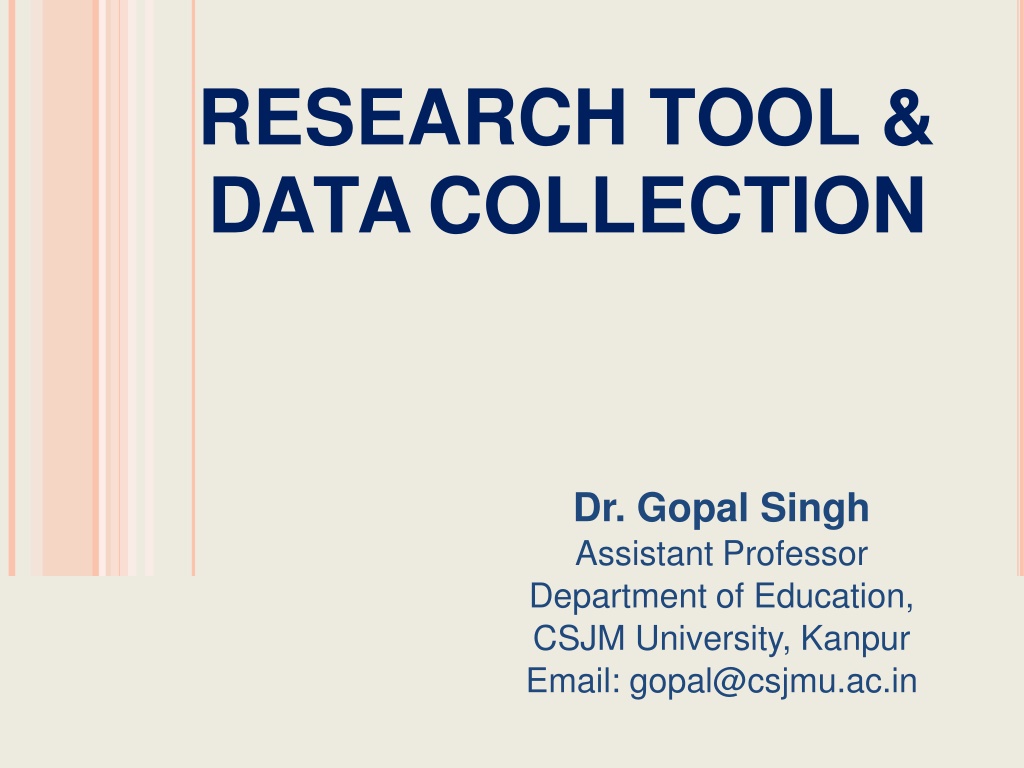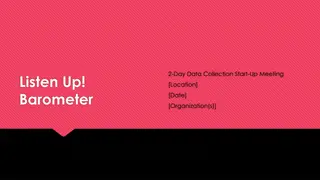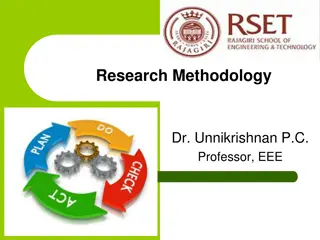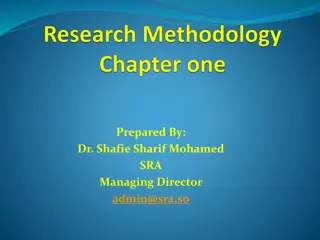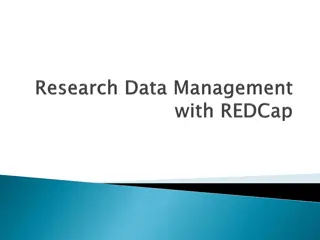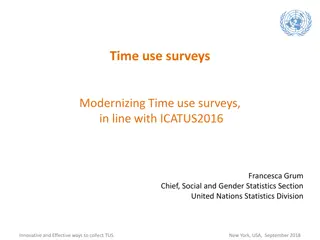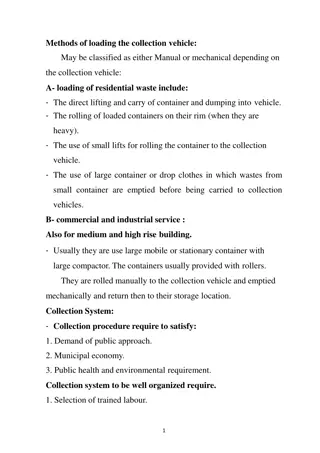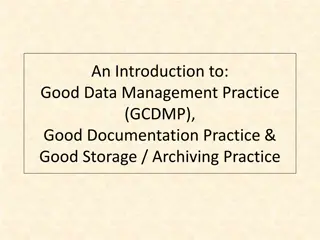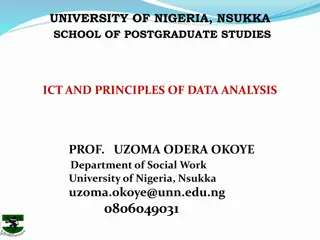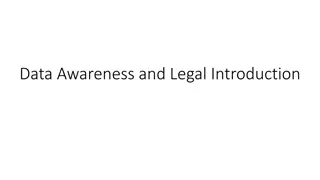Understanding Research Data Collection and Importance
Research data is essential for validating original research findings and can take various forms, both digital and non-digital. It plays a crucial role in improving lives, making informed decisions, solving problems, and ensuring strategic approaches. Data can be qualitative or quantitative, with qualities such as nominal and ordinal for qualitative data, and interval and ratio for quantitative data. Recognizing the types and significance of data is key in conducting effective research.
Download Presentation

Please find below an Image/Link to download the presentation.
The content on the website is provided AS IS for your information and personal use only. It may not be sold, licensed, or shared on other websites without obtaining consent from the author. Download presentation by click this link. If you encounter any issues during the download, it is possible that the publisher has removed the file from their server.
E N D
Presentation Transcript
RESEARCH TOOL & DATA COLLECTION Dr. Gopal Singh Assistant Professor Department of Education, CSJM University, Kanpur Email: gopal@csjmu.ac.in
WHAT IS DATA? Research data is any information that has been collected, observed, generated or created to validate original research findings. Although usually digital, research data also includes non-digital formats such as laboratory notebooks and diaries.
IMPORTANCE OF DATA Improve People s Lives Make Informed Decisions Stop Molehills From Turning Into Mountains Get The Results You Want Find Solutions To Problems Stop The Guessing Game Be Strategic In Your Approaches Know What You Are Doing Well Keep Track of It All Access The Resources Around You
TYPES OF DATA Qualitative Data - Nominal - Ordinal Quantitative Data - Interval - Ratio
QUALITATIVE DATA Qualitative data is defined as the data that approximates and characterizes. Qualitative data can be observed and recorded. This data type is non-numerical in nature. This type of data is collected through methods of observations, one-to- one interviews, conducting focus groups, and similar methods.
QUANTITATIVE DATA Quantitative data is defined as the value of data in the form of counts or numbers where each data-set has an unique numerical value associated with it. This data is any quantifiable information that can be used for mathematical calculations and statistical analysis, such that real-life decisions can be made based on these mathematical derivations.
NOMINAL It is not possible to state that Red is greater than Blue . The gender of a person is another one where we can t differentiate between male, female, or others.
ORDINAL These types of values have a natural ordering while maintaining their class of values. If we consider the size of a clothing brand then we can easily sort them according to their name tag in the order of small < medium < large. The grading system while marking candidates in a test can also be considered as an ordinal data type where A+ is definitely better than B grade.
INTERVAL SCALE Interval scale is defined as a numerical scale where the order of the variables is known as well as the difference between these variables. Variables that have familiar, constant, differences are classified using the Interval scale. and computable
RATIO SCALE Ratio Scale is defined as a variable measurement scale produces the order of variables but also makes the difference between variables known along with information on the value of true zero. that not only
DISCRETE DATA The numerical values which fall under are integers or whole numbers are placed under this category. The number of speakers in the phone, cameras, cores in the processor, the number of sims supported all these are some of the examples of the discrete data type.
CONTINUOUS DATA The fractional numbers are considered as continuous values. These can take the form of the operating frequency of the processors, the android version of the phone, wifi frequency, temperature of the cores, and so on.
Qualitative vs Quantitative Data Qualitative Data Overview: Deals with descriptions. Quantitative Data Overview: Deals with numbers. Data can be observed but not measured. Data which can be measured. Colors, textures, smells, tastes, appearance, beauty, etc. Length, height, area, volume, weight, speed, time, temperature, humidity, sound levels, cost, members, ages, etc. Quantitative Quantity Qualitative Quality
Example 1: Oil Painting Example 1: Oil Painting Qualitative data: Quantitative data: *red/green color, gold frame *smells old and musty *texture shows brush strokes of oil paint *peaceful scene of the country *masterful brush strokes *picture is 10" by 14 with frame 14" by 18 * weighs 8.5 pounds surface area of painting is 140 sq. in. *cost $300
Example 2: Latte Qualitative data: Example 2: Latte Quantitative data: *robust aroma *frothy appearance * strong taste *glass cup *12 ounces of latte *serving temperature 1500 F. *serving cup 7 inches in height *cost $4.95
Example 3: Freshman Class Example 3: Freshman Class Quantitative data: Qualitative data: *friendly demeanors *civic minded *environmentalists *positive school spirit *672 students *394 girls, 278 boys *68% on honor roll *150 students accelerated in mathematics
Make one qualitative observation about the picture above. Explain why this is a qualitative observation. Make one quantitative observation about the picture above. Explain why this is a quantitative observation.
Make one qualitative observation about the picture above. Explain why this is a qualitative observation. Make one quantitative observation about the picture above. Explain why this is a quantitative observation.
DEFINITION OF DATA COLLECTION Data collection is a systematic process of collecting detail information about desire objective from selected sample under controlled settings.
DATACOLLECTION: SOURCES Secondary data Sources Tertiary Sources Primary data Sources Personal contact observations is needed No direct contact to gather information. secondary sources. primary and identify and locate Sources that Face to face contact with the participants is required.
PRIMARY DATA COLLECTION: to gain general answers to basic questions. In-person surveys Direct observation When the researcher is directly involved with the study group. used to gain more in depth answers to complex questions. Interviews certain sample groups are asked their opinion about a certain subject or theory. Focus groups
Postal mail Electronic mail It is done : when very large group of population is required. When Personal contact is not possible for the researcher to collect the data. e.g: Institutional survey, organizational researchetc. T elephone Web-based surveys
SECONDARY DATA COLLECTION: Government publications Public records Business documents Historical and statistical documents Unpublished data
TERTIARY DATA COLLECTION: Indexes Bibliographies Encyclopedias Abstracts Biographical dictionaries & Other Resources
METHODS OF DATA COLLECTION: Method refers to the way of gathering data, a tool is an instrument used for the method. (1) Observation method (2) Interview method (3) Questionnaire
ONE OR MORE METHODS HAS/HAVE TO BE CHOSEN. THE CHOICE OF A METHOD DEPENDS UPON THE FOLLOWING FACTORS: The nature of the study of the subject-matter. The unit of enquiry. The size and spread of the sample. Scale of the survey. The educational level of respondents. The type and depth of information to be collected. The availability of skilled and trained manpower.
1) OBSERVATION TECHNIQUE: One of the basic method and oldest method. Data is obtained by investigator own direct observation without respondent. If observation is systematically planned and recorded can be used to checked for their validity and reliability. Assessed through senses with or without mechanical devices. Commonly used for behavioral studied. asking from the
Types of Observation Technique: STRUCTURED UNSTRUCTURED The observation does not take place as in structured observation. E.g. Explanatory studies Standardized condition of observation. Careful definition of units to be observed. The style of recording the observed information E.g. Descriptive studies
Advantages & Disadvantages of Observation Technique: Advantages 1) Subject bias is eliminated. Disadvantages 1) An expensive method 2) Relates to what is currently happening. 2) Information is very limited 3) Independent of respondent. 3) Unforeseen factors may interfere with the observational task.
2) INTERVIEW METHOD The interview method of collecting of data involves presentation of oral stimuli and reply in terms of oral response. It can be used through personal interviews and if possible, through telephone interview
CLASSIFICATION Personal interview Structured Unstructured Focused Clinical Non-directive A. B. C. D. E. Telephonic interview
Personal interviews: Asking question generally in a face to face to collect the information. The sort of investigation may be in the form of direct personal investigation or may be indirect .
CLASSIFICATION I. Personal Interview a) Structured interview: Involve the use of a set of predetermined questions and of highly standardized techniques of recording b) Unstructured interviews: Flexibility of approach to questioning. It doesn t follow a system of predetermined questions and standardized techniques of recording information.
c) Focused interview: To focus attention on the given experience of the respondent and its effects. d) Clinical interview: It is concerned with broad underlying feelings of individual's life experience. e) Non-directive interview: Encourage the respondent to talk about the given topic with a bare minimum of direct questioning
II. Telephone interview collecting information consists in contacting respondents on telephone. Advantage: It is more flexible in comparison to mailing method It is faster than other methods Recall is easy, call back are simple and economical Disadvantage: Shortage of time for respondents to reply Restricted to respondents who have telephone facilities
3) QUESTIONNAIRE: It comprises a series of questions prepared by the researcher that are answered and filled by all the respondent. This is usually popular self report or self- administered method. It commonly used to get demographic data. It allow the collection of larger data from large no. of sample quickly and inexpensively.
Structure of Question: Close Open ended question ended/fixed/alternative When researcher want more information. Limited respond. Easy to analysis difficult to analyze. e.g. Why did you choose to take your graduate work at this university? e.g. Have you ever taken a course in statistics? ( ) yes ( ) No
ADVANTAGES Can be posted, e-mailed or faxed. Can cover a large number of people or organizations. Wide geographic coverage. Relatively cheap. No prior arrangements are needed. Avoids embarrassment on the part of the respondent. Respondent can consider responses.
DISADVANTAGES: Design problems. Questions have to be relatively simple. Historically low response rate (although inducements may help). Time delay whilst waiting for responses to be returned. Require a return deadline. Several reminders may be required. Assumes no literacy problems. No control over who completes it. Not possible to give assistance if required.
References Best, John W. and Kahn James V (1995), Research in Education, Prentice Hall, New Delhi Koul, Lokesh (1988), Methodology of Educational Research, Vikas, New Delhi. R.A.Sharma ;Fundamentals of Educational Research : Meerut ,Loyal Book Depot, 2003 R.P.Bhatnagar (Ed.) Readings in Methodology of research in Education ;Meerut , R Lall Book Depot, 2002 http://www.vipinpatidar.wordpress.com/ https://www.researchgate.net/profile/Hamidreza_Saeidnia/post/What_tool_are_you_ using_for_prepare_schedule_of_research/attachment/5cc822393843b01b9b9d483 1/AS%3A753332331241477%401556619832993/download/9.pdf
